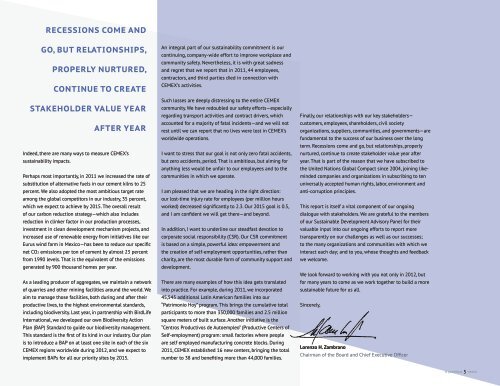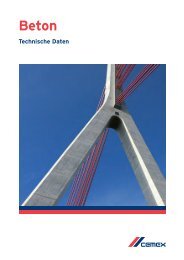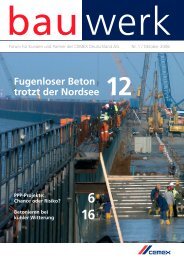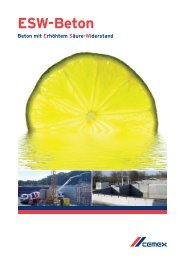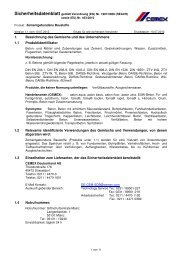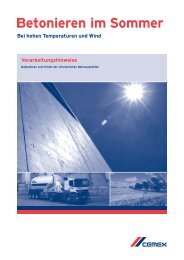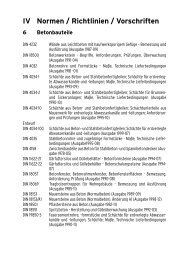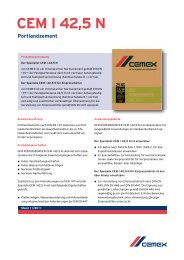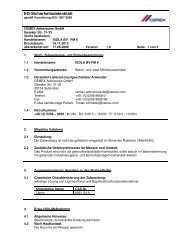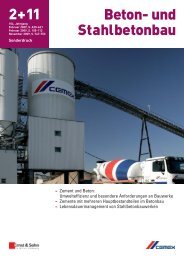building a better future - Cemex
building a better future - Cemex
building a better future - Cemex
You also want an ePaper? Increase the reach of your titles
YUMPU automatically turns print PDFs into web optimized ePapers that Google loves.
RECESSIONS COME AND<br />
GO, BUT RELATIONSHIPS,<br />
PROPERLY NURTURED,<br />
CONTINUE TO CREATE<br />
STAKEHOLDER VALUE YEAR<br />
AFTER YEAR<br />
Indeed, there are many ways to measure CEMEX’s<br />
sustainability impacts.<br />
Perhaps most importantly, in 2011 we increased the rate of<br />
substitution of alternative fuels in our cement kilns to 25<br />
percent. We also adopted the most ambitious target rate<br />
among the global competitors in our industry, 35 percent,<br />
which we expect to achieve by 2015. The overall result<br />
of our carbon reduction strategy—which also includes<br />
reduction in clinker factor in our production processes,<br />
investment in clean development mechanism projects, and<br />
increased use of renewable energy from initiatives like our<br />
Eurus wind farm in Mexico—has been to reduce our specific<br />
net CO2 emissions per ton of cement by almost 23 percent<br />
from 1990 levels. That is the equivalent of the emissions<br />
generated by 900 thousand homes per year.<br />
As a leading producer of aggregates, we maintain a network<br />
of quarries and other mining facilities around the world. We<br />
aim to manage those facilities, both during and after their<br />
productive lives, to the highest environmental standards,<br />
including biodiversity. Last year, in partnership with BirdLife<br />
International, we developed our own Biodiversity Action<br />
Plan (BAP) Standard to guide our biodiversity management.<br />
This standard is the first of its kind in our industry. Our plan<br />
is to introduce a BAP on at least one site in each of the six<br />
CEMEX regions worldwide during 2012, and we expect to<br />
implement BAPs for all our priority sites by 2015.<br />
An integral part of our sustainability commitment is our<br />
continuing, company-wide effort to improve workplace and<br />
community safety. Nevertheless, it is with great sadness<br />
and regret that we report that in 2011, 44 employees,<br />
contractors, and third parties died in connection with<br />
CEMEX’s activities.<br />
Such losses are deeply distressing to the entire CEMEX<br />
community. We have redoubled our safety efforts—especially<br />
regarding transport activities and contract drivers, which<br />
accounted for a majority of fatal incidents—and we will not<br />
rest until we can report that no lives were lost in CEMEX’s<br />
worldwide operations.<br />
I want to stress that our goal is not only zero fatal accidents,<br />
but zero accidents, period. That is ambitious, but aiming for<br />
anything less would be unfair to our employees and to the<br />
communities in which we operate.<br />
I am pleased that we are heading in the right direction:<br />
our lost-time injury rate for employees (per million hours<br />
worked) decreased significantly to 2.3. Our 2015 goal is 0.5,<br />
and I am confident we will get there—and beyond.<br />
In addition, I want to underline our steadfast devotion to<br />
corporate social responsibility (CSR). Our CSR commitment<br />
is based on a simple, powerful idea: empowerment and<br />
the creation of self-employment opportunities, rather than<br />
charity, are the most durable form of community support and<br />
development.<br />
There are many examples of how this idea gets translated<br />
into practice. For example, during 2011, we incorporated<br />
45,545 additional Latin American families into our<br />
“Patrimonio Hoy” program. This brings the cumulative total<br />
participants to more than 350,000 families and 2.5 million<br />
square meters of built surface. Another initiative is the<br />
“Centros Productivos de Autoempleo” (Productive Centers of<br />
Self-employment) program: small factories where people<br />
are self employed manufacturing concrete blocks. During<br />
2011, CEMEX established 16 new centers, bringing the total<br />
number to 38 and benefiting more than 44,000 families.<br />
Finally, our relationships with our key stakeholders—<br />
customers, employees, shareholders, civil society<br />
organizations, suppliers, communities, and governments—are<br />
fundamental to the success of our business over the long<br />
term. Recessions come and go, but relationships, properly<br />
nurtured, continue to create stakeholder value year after<br />
year. That is part of the reason that we have subscribed to<br />
the United Nations Global Compact since 2004, joining likeminded<br />
companies and organizations in subscribing to ten<br />
universally accepted human rights, labor, environment and<br />
anti-corruption principles.<br />
This report is itself a vital component of our ongoing<br />
dialogue with stakeholders. We are grateful to the members<br />
of our Sustainable Development Advisory Panel for their<br />
valuable input into our ongoing efforts to report more<br />
transparently on our challenges as well as our successes;<br />
to the many organizations and communities with which we<br />
interact each day; and to you, whose thoughts and feedback<br />
we welcome.<br />
We look forward to working with you not only in 2012, but<br />
for many years to come as we work together to build a more<br />
sustainable <strong>future</strong> for us all.<br />
Sincerely,<br />
Lorenzo H. Zambrano<br />
Chairman of the Board and Chief Executive Officer<br />
< previous 5 next>


